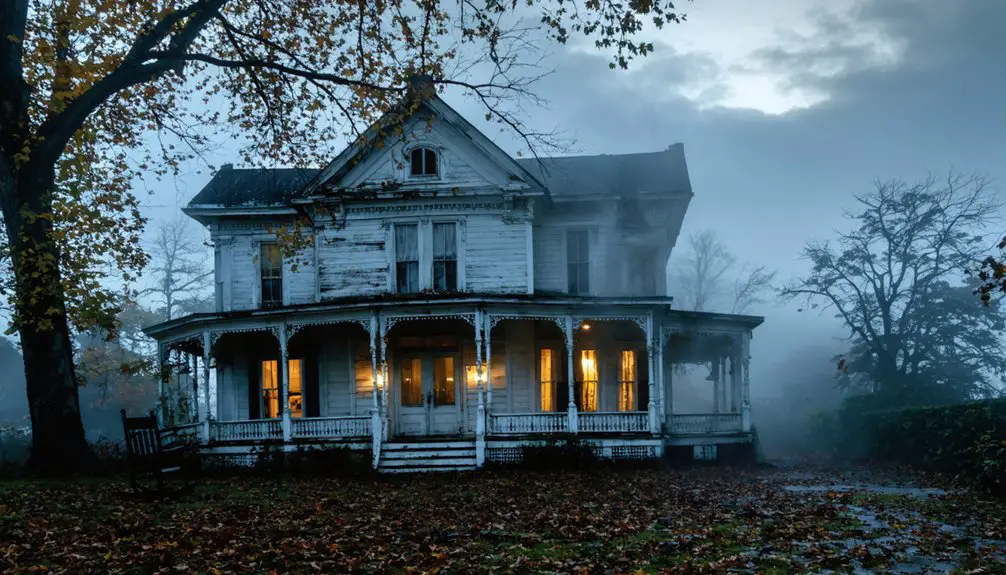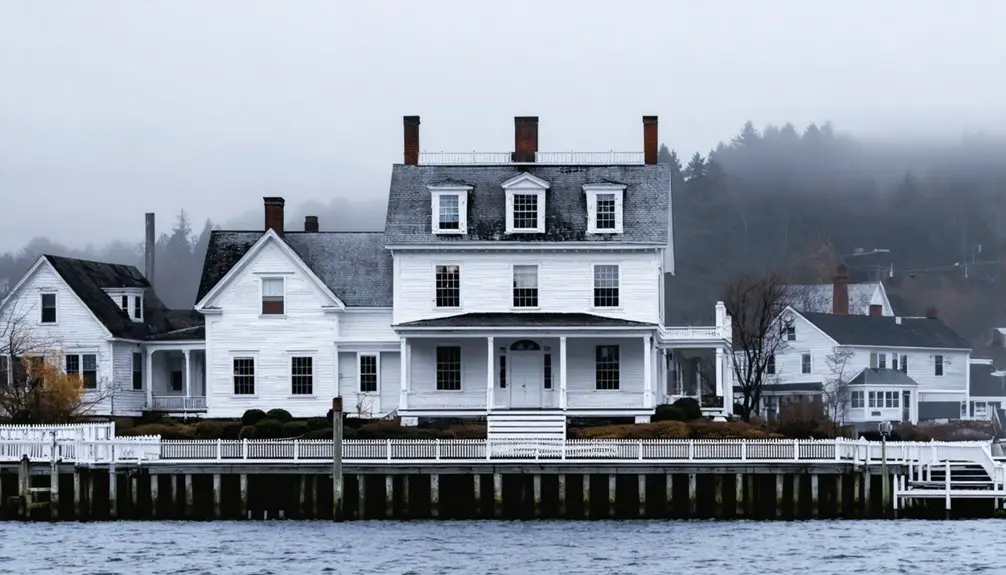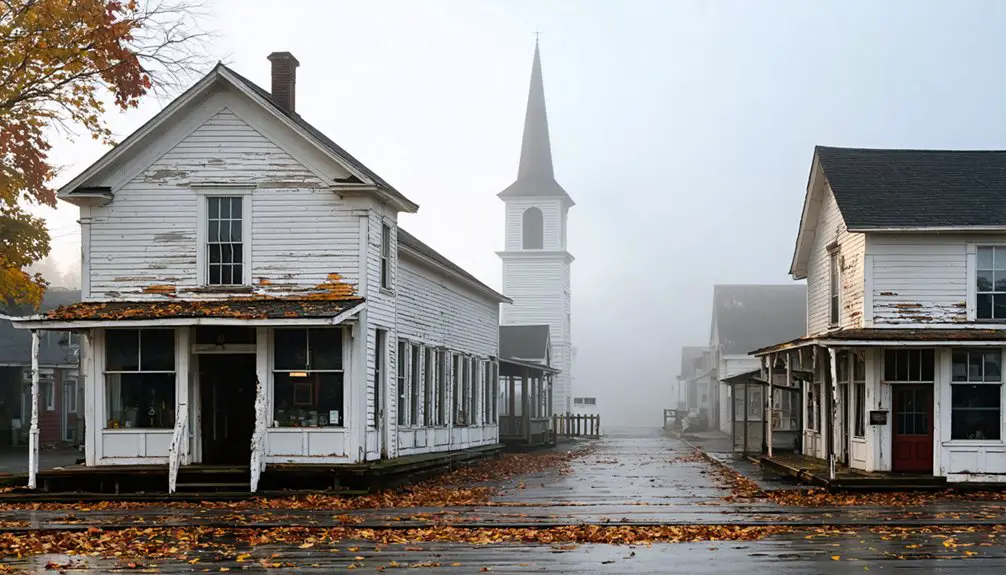You’ll find Port Gamble, Washington as a remarkably preserved New England-style mill town on Gamble Bay. Founded in 1853 by the Puget Mill Company, it operated continuously for 142 years until the Pope & Talbot Mill closed in 1995. Today, this National Historic Landmark district showcases authentic Victorian architecture, haunted heritage sites, and historic worker homes. Beyond its ghost town status, Port Gamble’s rich history and supernatural legacy hold countless fascinating stories.
Key Takeaways
- Port Gamble became a ghost town after its primary economic driver, the Pope & Talbot sawmill, closed in 1995 after 142 years.
- The town preserves its original New England-style architecture, including Victorian homes, worker residences, and historic commercial buildings.
- Despite its ghost town status, Port Gamble remains a National Historic Landmark featuring guided tours and heritage tourism activities.
- The town’s haunted reputation draws paranormal enthusiasts, with five documented haunted locations including the Walker-Ames House.
- Port Gamble transformed from a bustling mill town to a quiet historic district maintaining authentic 19th-century buildings and streets.
The Founding of a Historic Mill Town
When William Talbot and Andrew Pope left their hometown of East Machias, Maine in 1849, they saw tremendous opportunity in the booming Western lumber trade. Partnering with Josiah Keller and Charles Foster, they established the Puget Mill Company, selecting a strategic site on Gamble Bay in 1853 for its deep waters and rich forest access. The Native American S’Klallam tribe was displaced from their ancestral lands to make way for the new settlement.
You’ll find that building the mill workforce proved challenging in the frontier conditions. To solve this, they recruited experienced workers from Maine, creating a unique cultural integration as New England traditions met the Pacific Northwest.
They constructed housing and amenities reflecting East Coast architecture to help homesick workers adjust. By September 1853, with the boiler, engine, and muley saw in place, the mill began cutting its first logs, launching what would become one of America’s longest-running sawmill operations. The company’s success grew rapidly, as they expanded to own and operate ten shipping vessels by 1862.
New England Architecture in the Pacific Northwest
When you explore Port Gamble’s historic district, you’ll notice the striking Victorian and New England architectural elements that mirror Maine’s seaside communities, from the steep-pitched roofs to the symmetrical facades with classical columns.
The buildings showcase distinctive East Coast features including double-hung windows with multiple panes, painted wood clapboard siding, and decorative shutters that transport you to a traditional New England waterfront. Many homes feature paired chimneys and hip roofs characteristic of Georgian architecture.
The town’s careful layout places these grand structures along the waterfront and main thoroughfare, creating a cohesive maritime aesthetic that exemplifies the founders’ determination to recreate their East Coast heritage in the Pacific Northwest. The homes incorporate exposed timber beams to add warmth and celebrate traditional craftsmanship.
Victorian Style Building Features
Port Gamble’s architectural heritage stands as a remarkable fusion of Victorian and New England building traditions transported to the Pacific Northwest.
You’ll find stunning Victorian details throughout the town, especially in landmarks like the Walker-Ames House, built in 1888-1889. The architectural adaptations showcase steep roofs with cross gables, clapboard siding, and decorative elements like turned porch posts and molded window trims. The Columbus Day Storm caused significant destruction to several historic structures in 1962.
These Victorian homes weren’t just beautiful – they were practical too, featuring modern amenities like indoor bathrooms. The town’s distinctive look comes from its tree-lined streets with mature maple and elm trees providing shade.
Local craftsmen made extensive use of the region’s abundant timber, creating intricate millwork that sets Port Gamble’s structures apart. The buildings’ steep pitched roofs were designed to handle the Pacific Northwest’s heavy rainfall while maintaining the elegant Queen Anne style that defined the era.
East Coast Design Elements
Throughout Port Gamble’s architectural landscape, you’ll discover striking examples of New England design elements that early settlers transplanted to the Pacific Northwest. The town’s Colonial Revival homes showcase symmetrical facades, classical columns, and shuttered windows that mirror their East Coast counterparts, while incorporating local materials that connect them to their Pacific surroundings.
You’ll notice the distinctive Shingle Style influence in buildings with their continuous wood shingle cladding, steeply pitched roofs, and minimal ornamentation. These traditional designs often incorporate reclaimed and salvaged materials, giving each structure an authentic historical feel. Drawing from Queen Anne style influences, these homes feature tall, narrow windows that enhance their vertical proportions.
These homes often feature towers, bay windows, and irregular footprints that create visual interest while maintaining rustic simplicity. The extensive use of wood, from exterior siding to interior finishes, reflects both New England’s colonial timber traditions and the Pacific Northwest’s natural abundance, creating a seamless blend of East Coast elegance and Western practicality.
Seaside Town Building Layout
As designed by Josiah Keller in 1858, the strategic layout of Port Gamble’s 85 lots takes full advantage of its coastal position, with buildings arranged along a scenic bluff overlooking the bay.
The lot organization reflects the town’s deep connection to its lumber industry heritage, creating a compact, walkable community where you’ll find carefully planned spaces serving both residential and industrial needs. The town’s master plan continues this tradition by enhancing existing charm while accommodating future growth.
You’ll discover three key features of Port Gamble’s waterfront access and layout:
- The mill’s essential buildings, including the sawmill and bunkhouse, were positioned on a sandy pit next to the bay.
- Worker housing lots were strategically placed on company-owned land following the plat approval.
- Buildings face the waterfront, maximizing views while maintaining functional industrial access.
Life and Legacy of the Pope & Talbot Mill
Port Gamble’s Pope & Talbot mill was a showcase of business savvy and endurance, operating continuously for over 140 years as North America’s longest-running sawmill.
From its strategic start in 1853, the company expanded to control 186,000 acres of timberland by 1892 while establishing a global shipping network reaching Australia, Peru, England, and Hawaii.
The company took significant steps toward vertical integration when it hired logging crews and began harvesting its own land in the early 1900s to reduce operational costs.
The mill’s economic influence shaped Port Gamble’s destiny until its final whistle in 1995, leaving behind a rich heritage of lumber innovation and community building that defined the Pacific Northwest’s timber era.
Mill Operations and Growth
When Captain William C. Talbot established the Puget Mill Company in 1853, you’d witness the birth of one of North America’s most enduring sawmill innovations.
The mill’s strategic location at Teekalet (later Port Gamble) positioned it perfectly for timber industry dominance.
You’ll find these remarkable achievements defined the mill’s growth:
- Integration of advanced steam technology that set new standards for Pacific Northwest operations
- Expansion to 186,000 acres of timberland ownership by 1892
- Development of a global export network reaching Australia, Peru, England, and Hawaii
The company’s savvy business moves included acquiring additional mills at Utsalady and Port Ludlow in the 1870s.
After a brief sale in 1925, the founders’ descendants regained control in 1938, leading to its corporate evolution into Pope & Talbot, Inc. in 1940.
Community Impact and Closure
The 1995 closure of Port Gamble’s Pope & Talbot Mill marked the end of a remarkable 142-year legacy that had defined the region’s industrial heritage.
As the mill’s operations ceased, you’d have witnessed a profound economic change that reshaped the town’s identity. Once-bustling streets grew quiet as workers departed, and businesses that had thrived on mill activity faced unprecedented challenges.
Yet Port Gamble’s story didn’t end there. The community’s resilience emerged through a strategic shift toward heritage tourism and preservation.
You’ll find the town’s historical structures carefully maintained, telling the story of one of Washington’s earliest company towns. While the population has diminished and many shops have closed or found new purposes, Port Gamble’s transformation from industrial powerhouse to historical destination showcases its ability to adapt and endure.
Haunted Heritage and Supernatural Stories

Steeped in more than a century of mysterious encounters, Port Gamble’s haunted heritage draws paranormal enthusiasts and history buffs from across the Pacific Northwest.
You’ll discover a town where ghost encounters have been documented since the 1950s, with the Walker-Ames House standing as the most spiritually active site.
If you’re brave enough to explore Port Gamble’s haunted history, you’ll find:
- Five prominent haunted locations, including the historic General Store, Franklin Lodge No. 5, and St. Paul’s Church
- Regular paranormal investigations led by local expert Pete “Paranormal Pete” Orbea
- The Buena Vista Cemetery, established in 1856, where apparitions frequently appear
You can join guided ghost walks from October to April, using recording devices to capture unexplained voices and sounds in these perfectly preserved historic buildings.
From Lumber Hub to Tourist Destination
Founded in 1853 by visionaries Andrew J. Pope and Captain William Talbot, Port Gamble transformed from a modest sawmill into North America’s longest-running lumber operation.
You’ll find yourself walking through a remarkable piece of lumber history, where the Puget Mill Company once shipped timber to 37 ports worldwide and owned 186,000 acres of timberland.
The town’s preserved New England architecture now draws visitors instead of lumber workers, showcasing its evolution from an industrial powerhouse to a cherished tourist attraction.
You can explore the original worker homes, cookhouse, and store that once served a thriving mill community.
While the sawmill’s 142-year reign has ended, Port Gamble’s heritage lives on through its authentic 19th-century buildings and the stories of the pioneers who built this iconic Pacific Northwest lumber town.
Preserving Port Gamble’s Living History

Through collaborative conservation efforts spanning decades, Port Gamble‘s living history now extends far beyond its preserved buildings to encompass nearly 1,900 acres of protected watershed and 3,400 acres of Heritage Park land.
You’ll find cultural preservation at work through partnerships between Coast Salish Tribes, local residents, and conservation groups, ensuring this National Historic Site maintains its historical significance.
- The Port Gamble S’Klallam Tribe manages restoration projects like Heronswood Garden, blending cultural heritage with ecological stewardship.
- Over 8,500 creosote-treated pilings and 110,000 cubic yards of contaminated sediment have been removed to restore natural habitats.
- Tribal acquisition of development rights on culturally significant lands, including the former mill site, protects both heritage and natural resources.
These preservation efforts honor both the land’s industrial past and its Indigenous connections while securing its future.
Frequently Asked Questions
What Native American Tribes Originally Inhabited the Port Gamble Area?
You’ll find the Port Gamble S’Klallam and Chemakum tribes, both Coast Salish peoples, originally inhabited this area alongside the Nooksclime and Clallam tribes, who shared these ancestral lands.
Are There Any Restrictions on Taking Photographs Inside Historic Buildings?
You’ll need explicit permission before snapping away – historic preservation policies generally restrict indoor photography. You can’t use flash or tripods without approval, and some buildings entirely prohibit taking pictures inside.
How Much Does It Cost to Rent Historic Buildings for Events?
You’ll find event pricing ranges from $1,050 to $6,300, with rental agreements varying by venue. Hood Canal Pavilion costs $2,600-$5,800, St. Paul’s Church charges $350/hour, and museum rentals are $100/hour.
What Transportation Options Are Available to Reach Port Gamble From Seattle?
You can take ferry services from Seattle to Bremerton, then connect via Kitsap Transit buses, or drive 89 miles via highways to reach Port Gamble at your own pace.
Does Port Gamble Offer Accommodation Options Besides the Historic Guest Houses?
You won’t find alternative lodging directly in Port Gamble beyond the guest houses, but you’ll discover plenty of local amenities and accommodations in nearby Kingston, Poulsbo, and Port Ludlow within 2-11 miles.
References
- https://keyw.com/port-gamble-washington-haunted/
- https://kitsapsmokestack.org/2023/10/06/just-a-regular-guy-who-talks-to-ghosts/
- https://1889mag.com/explore/where-ghosts-convene/
- https://wsmag.net/people-and-places/2023-10-23/port-gamble-and-its-long-term-residents/
- https://www.youtube.com/watch?v=hXTQolbryv0
- https://en.wikipedia.org/wiki/Port_Gamble
- https://rainshadownorthwest.com/2024/01/05/port-gamble-the-future-of-the-past/
- https://americasbesthistory.com/spotlight2020-4.html
- https://www.wanderwithwonder.com/port-gamble-washington-a-company-lumber-town-with-a-modern-vibe/
- https://www.portgamble.com/about/



